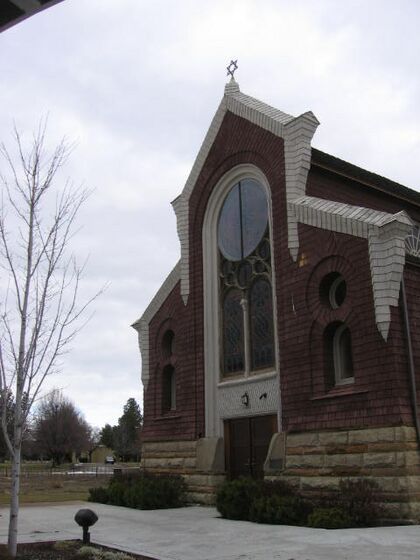Ahavath Beth Israel (Boise, Idaho) facts for kids
Quick facts for kids Ahavath Beth Israel |
|
|---|---|

Ahavath Beth Israel synagogue, in 2010
|
|
| Religion | |
| Affiliation | Reform Judaism |
| Rite | Nusach Ashkenaz |
| Ecclesiastical or organisational status | Synagogue |
| Leadership | Rabbi Daniel B. Fink |
| Status | Active |
| Location | |
| Location | 11 North Latah Street, Boise, Idaho 83706 |
| Country | United States |
| Architecture | |
| Architect(s) | Chestney & Schroeder |
| Architectural type | Synagogue architecture |
| Architectural style |
|
| General contractor | Judkins & Co. |
| Date established | 1986 (merged congregation)
|
| Groundbreaking | 1895 |
| Completed |
|
| Construction cost | $3,159 |
| Materials | Wood, shingles |
Ahavath Beth Israel is a special Jewish place of worship, called a synagogue, located in Boise, Idaho. Its full name is Congregation Ahavath Beth Israel. The name comes from Hebrew and means "Love of the House of Israel."
This synagogue is very old. Its building, built in 1896, is one of the oldest synagogues still used today west of the Mississippi River in the United States. It belongs to the Reform Judaism movement.
Contents
History of the Synagogue
Early Jewish Community in Boise
The first Jewish people arrived in Boise in the 1860s. They came to work in the mining camps. Over time, their community grew.
In 1895, the first Jewish group was officially formed. It was called Congregation Beth Israel. This name means "House of Israel" in Hebrew. Most of these early members came from Germany and Central Europe. They followed the Reform Jewish tradition.
A very important leader of this early group was Moses Alexander. He later became the mayor of Boise. He also served as the governor of Idaho.
Building the First Synagogue
The original synagogue building was finished in 1896. It was carefully restored in 1982. This made sure the old building stayed in good condition.
A New Congregation Forms
In 1912, another Jewish group started in Boise. It was called Congregation Ahavath Israel. This name means "Love of Israel" in Hebrew. This group was made up of Orthodox Jewish immigrants. They came from Eastern Europe.
This new congregation built its own synagogue in 1947. It was located on the corner of 27th and Bannock Streets.
Two Congregations Become One
In 1986, the two congregations decided to join together. Congregation Beth Israel and Congregation Ahavath Israel merged. They became one new group called Ahavath Beth Israel. This brought together different parts of the Jewish community in Boise.
The Synagogue Building
Unique Architectural Style
The synagogue building was built in 1896. It has wood shingles on the outside. Its design mixes two popular styles from that time. These styles were often used for Jewish buildings.
The main style is called Rundbogenstil. This is a German word meaning "round arch style." You can see this in the rounded shapes of the building. The tall windows next to the large, round rose window have a special shape. They look like Horseshoe arches. This is a detail from Moorish Revival style.
Inside the synagogue, this Moorish style continues. The ceiling is shaped like a barrel-vault. It is supported by more horseshoe arches. The architect who designed the building said it was in a "modern Moorish style."
Historic Recognition and Relocation
In 1972, the Ahavath Beth Israel synagogue was added to the National Register of Historic Places. This means it is recognized as an important historic site.
In 2003, something amazing happened. The entire building was moved from its first location on State Street. It was carefully moved to its current spot on Latah Street. During this big move, workers found old papers. These papers showed that famous people helped pay for the original building. These included Marshall Field and Levi Strauss & Co..


